Key takeaways:
- Equal pay advocacy emphasizes the need for fair compensation across all demographics and challenges systemic biases in the workplace.
- Successful petitions unify voices and draw attention to urgent issues, turning personal stories into collective movements for change.
- Effective petitions require clarity in messaging, emotional connection, and timely relevance to current events to increase engagement.
- Building community and offering clear actions empower supporters and enhance the advocacy efforts for causes like equal pay.
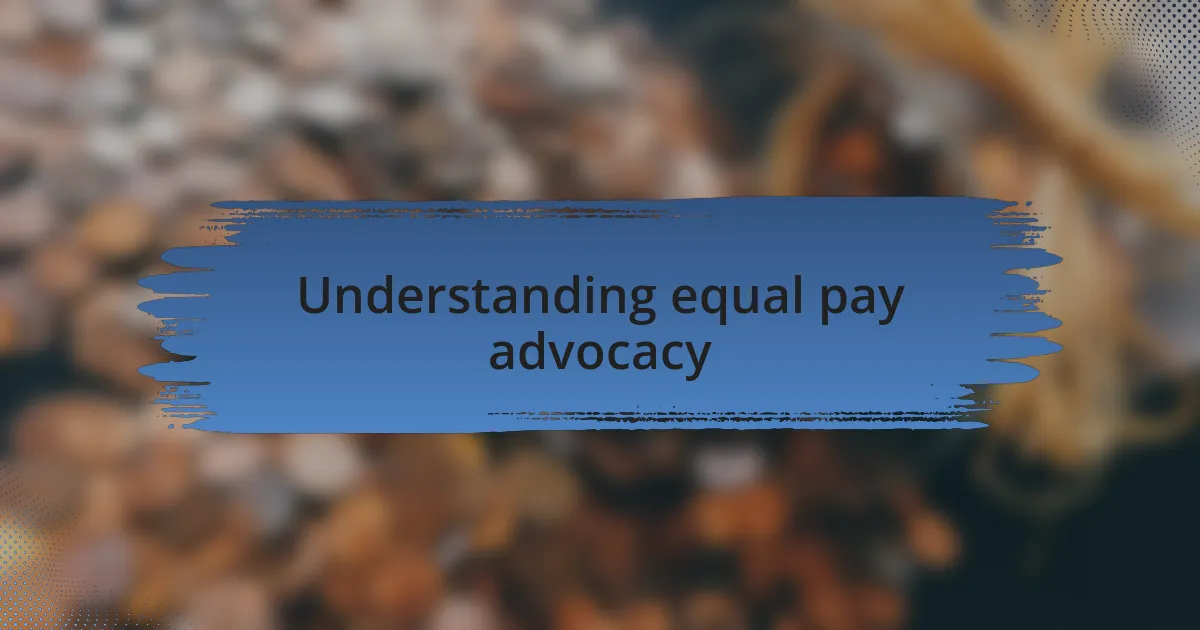
Understanding equal pay advocacy
Equal pay advocacy is rooted in the belief that everyone deserves fair compensation for their work, regardless of gender, race, or socioeconomic background. I remember when a friend of mine fought for the same salary as her male colleagues after discovering they were earning significantly more for the same role. It was a tough journey, but it highlighted the deep-seated biases that persist in the workplace.
When I think about equal pay advocacy, I can’t help but wonder: why should anyone endure the burden of financial disparity simply based on their identity? The reality is that countless individuals experience wage gaps that affect their livelihoods and quality of life. I’ve seen firsthand how those discrepancies can impact not just families, but entire communities, reinforcing cycles of inequality and diminishing morale.
Engaging in equal pay advocacy means challenging the status quo and pushing for systemic change. I often find myself reflecting on the power of collective action; when we stand together and raise our voices, we bring attention to these injustices. It’s an inspiring reminder that each of us has a role in creating a fairer, more equitable workplace for all.
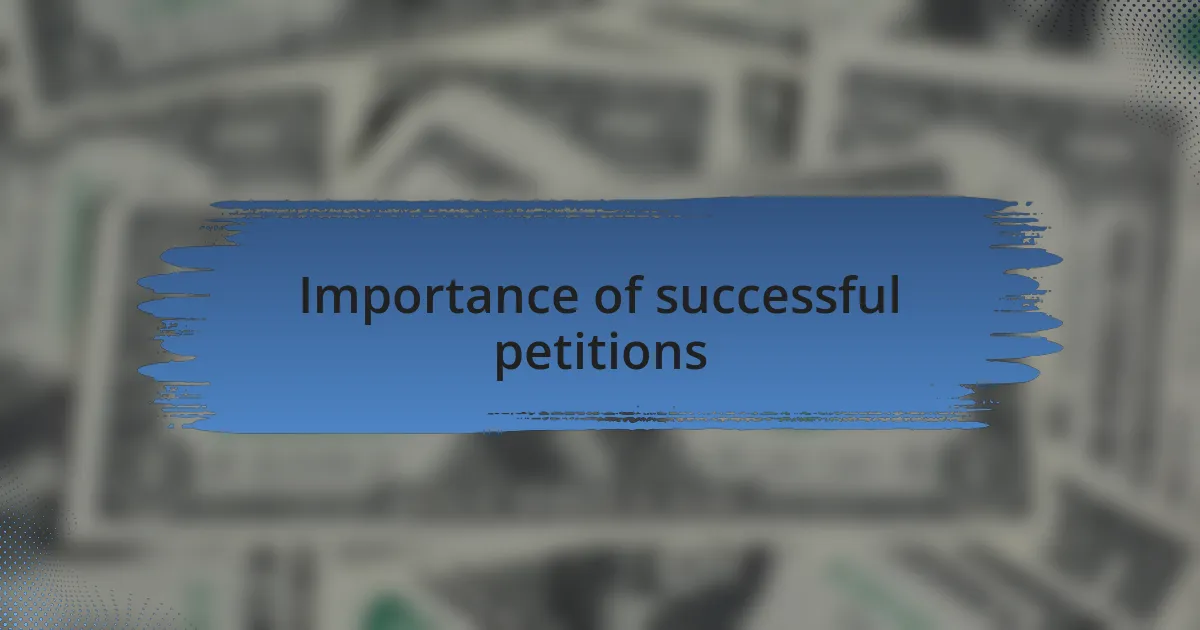
Importance of successful petitions
Successful petitions serve as the backbone of advocacy movements, providing a clear and unified voice for the cause. The power of a well-drafted petition lies in its ability to galvanize support and spark conversations that lead to meaningful change. I’ll never forget the incredible moment when a petition I signed not only gathered thousands of signatures but also led to a town hall meeting where community members confronted decision-makers directly.
Moreover, petitions often signify the urgency of an issue, capturing the attention of lawmakers and the public alike. For instance, I once participated in a campaign that collected signatures to demand equal pay for caregivers—a role many people undervalue despite its importance. The response was overwhelming, illustrating how petitions can turn individuals’ frustrations into a collective movement, amplifying our shared experiences and serving as a call to action.
What’s fascinating to me is how successful petitions can create a ripple effect, inspiring others to join the fight for fairness. When I see friends and family rallying behind a cause, it reinforces my belief that each signature represents not just a name, but a story and a struggle for equality. Who knows how many lives could change as a result of these efforts? Each petition can ignite awareness and propel discussions that extend beyond its initial goal.
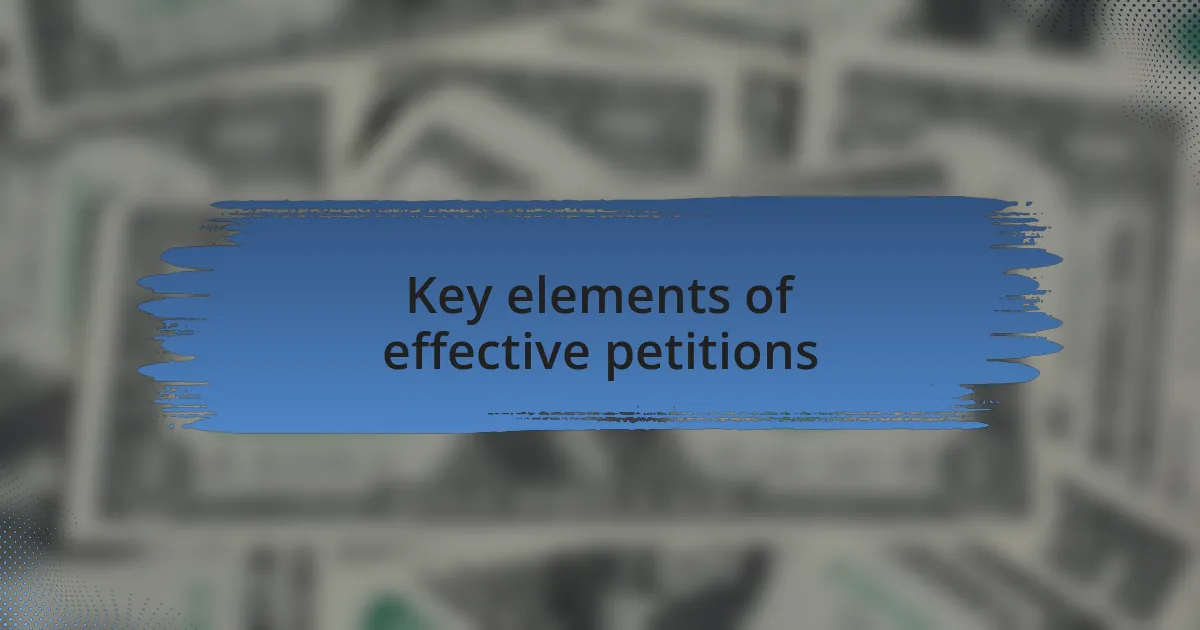
Key elements of effective petitions
One key element of effective petitions is clarity in the message. When I think about the petitions that motivated me the most, it always comes down to clear communication about what is being asked. For instance, I recall a local initiative that sought to improve public transportation. The petition clearly stated specific changes and provided reasoning behind them, making it easy for people to understand why signing was important. How can anyone support a cause if they don’t fully grasp what’s at stake?
Another crucial factor is emotional resonance. Effective petitions often connect with people on a personal level. I remember a petition advocating for equal pay in public service that included stories from various individuals—teachers, nurses, and public defenders—sharing their experiences of struggle. These narratives transformed statistics into relatable human experiences, prompting many to reflect on their own stories and join the movement. Isn’t it easier to support something when you can see yourself in it?
Lastly, timing can dramatically influence a petition’s effectiveness. I once navigated a challenging campaign centered around workplace equality during a nationwide conversation about gender pay gaps. That timing amplified our message, capturing public interest at precisely the right moment. It made me realize that a petition can create urgency, but aligning that sense of urgency with current events can elevate its impact. Have you ever noticed how the right context can turn a good idea into a rallying cry?
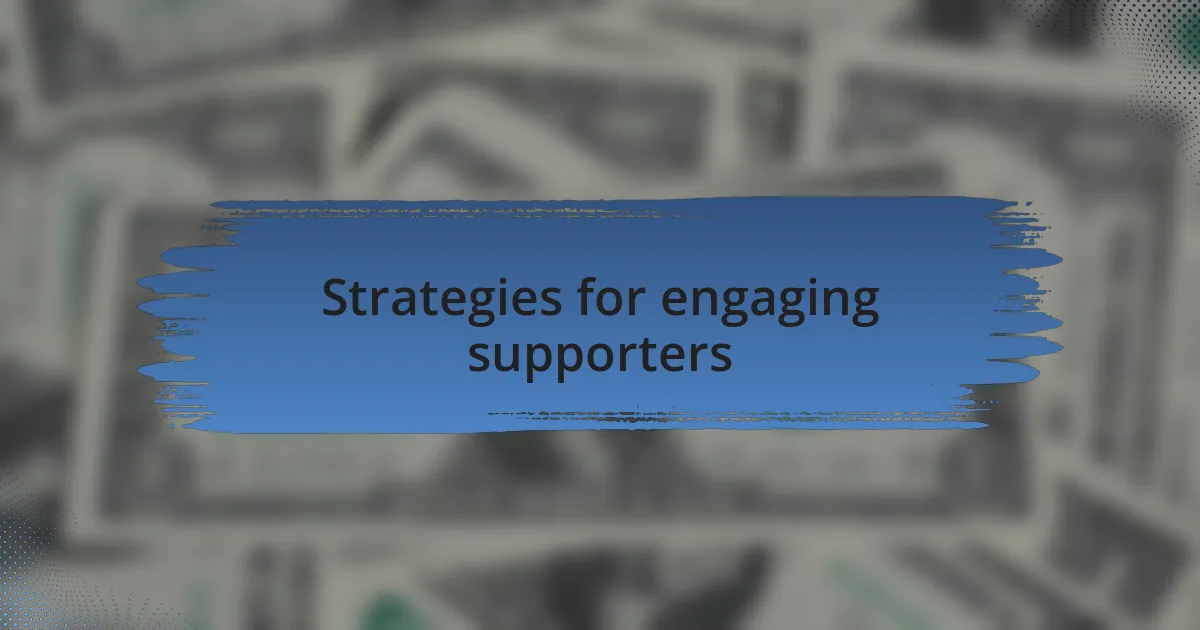
Strategies for engaging supporters
Engaging supporters effectively begins with building a community around the cause. In my experience, creating a shared space—whether through social media groups or local gatherings—allows for organic connections. I remember attending a grassroots meeting for equal pay advocacy, where supporters exchanged stories and rallied together. That sense of belonging can turn passive followers into active participants. Have you thought about how much stronger a movement feels when it’s fueled by shared convictions?
Another strategy involves utilizing storytelling to foster a deeper connection. I’ve found that weaving personal experiences into communications makes supporters more likely to engage. For instance, sharing how the pay gap has affected real lives can strike a chord. I once wrote a post about a single mom juggling multiple jobs, and the responses poured in—people related to her struggle and felt compelled to act. Isn’t it powerful how narratives can transform abstract issues into urgent calls for action?
Lastly, offering clear and accessible ways for supporters to contribute is vital. When I launched a campaign for equitable pay, I devised action steps that ranged from signing the petition to attending local meetings or sharing on social media. By breaking down involvement into manageable tasks, I noticed more people felt encouraged to help. Have you experienced that moment of empowerment when you realize you can be part of something meaningful?
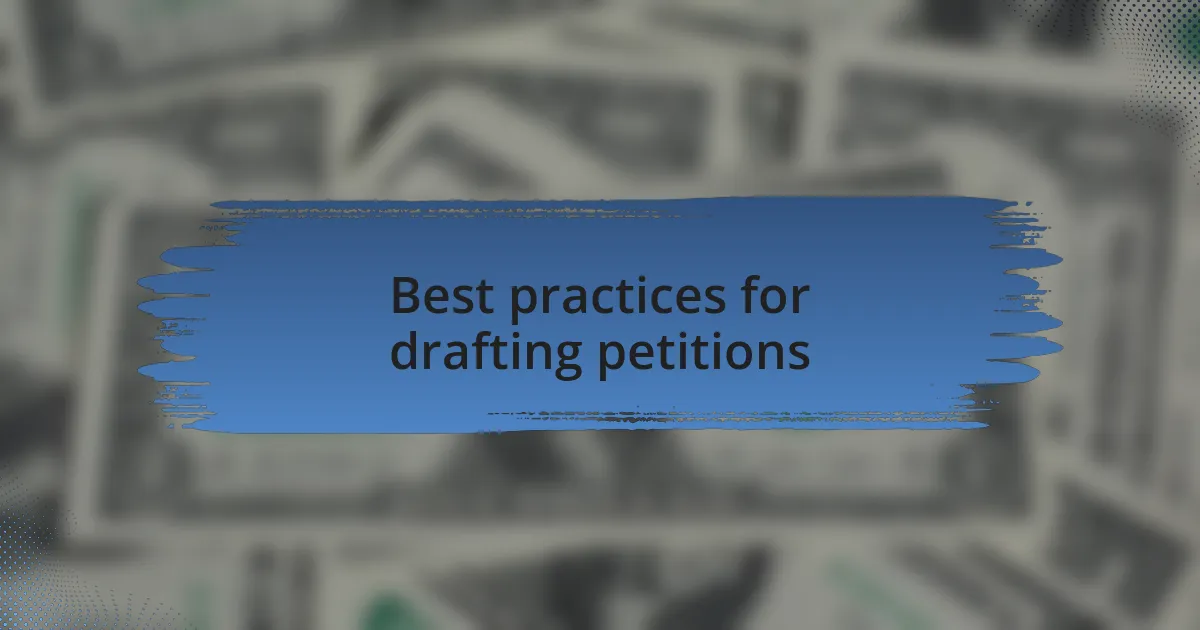
Best practices for drafting petitions
Crafting a petition that resonates involves clarity and precision. I’ve discovered that stating the issue and the desired outcome succinctly can significantly impact engagement. When I wrote a petition for equal pay, I focused on a clear, one-sentence ask—“We demand equal pay for equal work!” This direct approach not only captures attention but also makes it easy for supporters to understand the goal. Doesn’t it feel empowering to know exactly what you’re advocating for?
Incorporating personal stories can elevate a petition from merely informative to deeply compelling. During a campaign, I included testimonials from individuals who had faced pay disparities, which made the petition more relatable. I vividly recall one response where a young woman shared how she personally battled with unequal pay, and her story sparked a wave of support. Isn’t it fascinating how personal connections can transform dry statistics into passionate pleas?
Lastly, presenting the petition visually can enhance its appeal. I’ve experimented with infographics that lay out the key facts and figures behind the pay gap, combined with impactful images. These visuals not only grab attention but also help convey complex information quickly. Have you noticed how a striking image can communicate urgency in a way that words sometimes can’t?
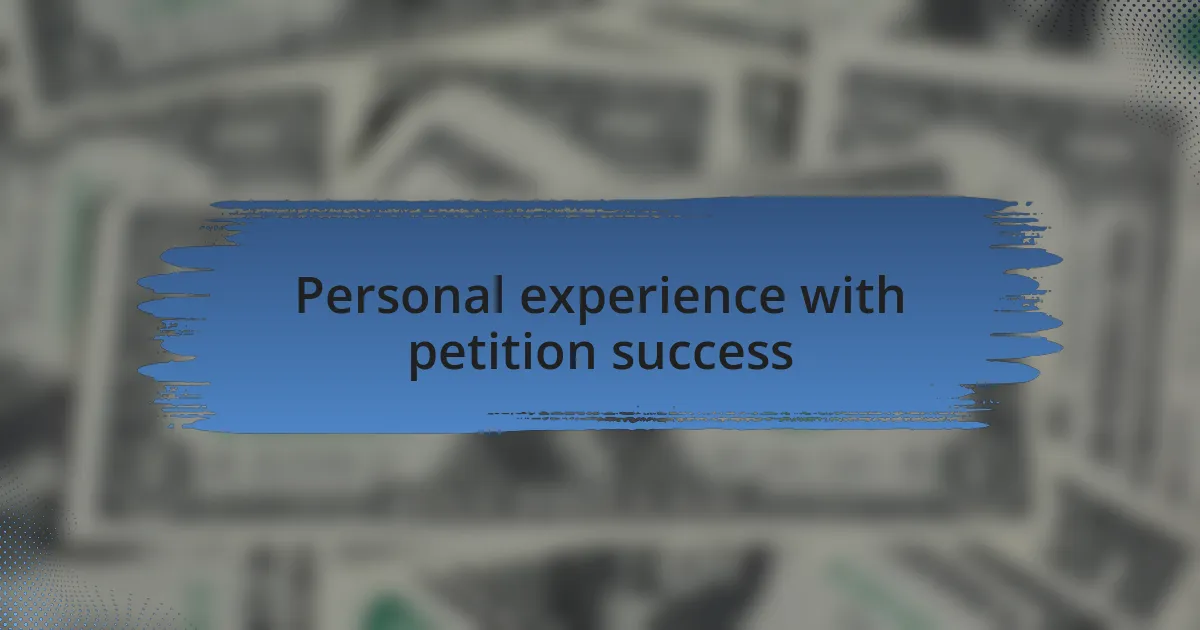
Personal experience with petition success
One of my most memorable experiences with petition success came when I collaborated with a small group to advocate for equal pay within our industry. We each shared our experiences of wage discrimination, and I was struck by the emotional weight in those stories. It’s not just about numbers; it’s about lives and dreams affected by unfair pay. How could we not rally behind such powerful testimonies?
In another instance, I created a petition after witnessing a colleague receive far less compensation than a male counterpart, despite identical qualifications. I remember the frustration boiling inside me; it felt unjust, and I knew we had to do something. By framing the petition around this real-life scenario, we not only received overwhelming support but also ignited conversations within our workplace about pay equity that hadn’t existed before. Isn’t it incredible how voicing one person’s struggle can inspire a movement?
Reflecting on my experiences, I’ve learned that petitions thrive on shared passion and urgency. When I participated in a national campaign, we experienced an unexpected surge of endorsements after one of our advocates went live on social media to discuss their story with pay inequality. It’s those personal connections that resonate deeply, making the cause feel real and pressing. Doesn’t it seem that a unifying narrative can turn distant issues into compelling calls for action?
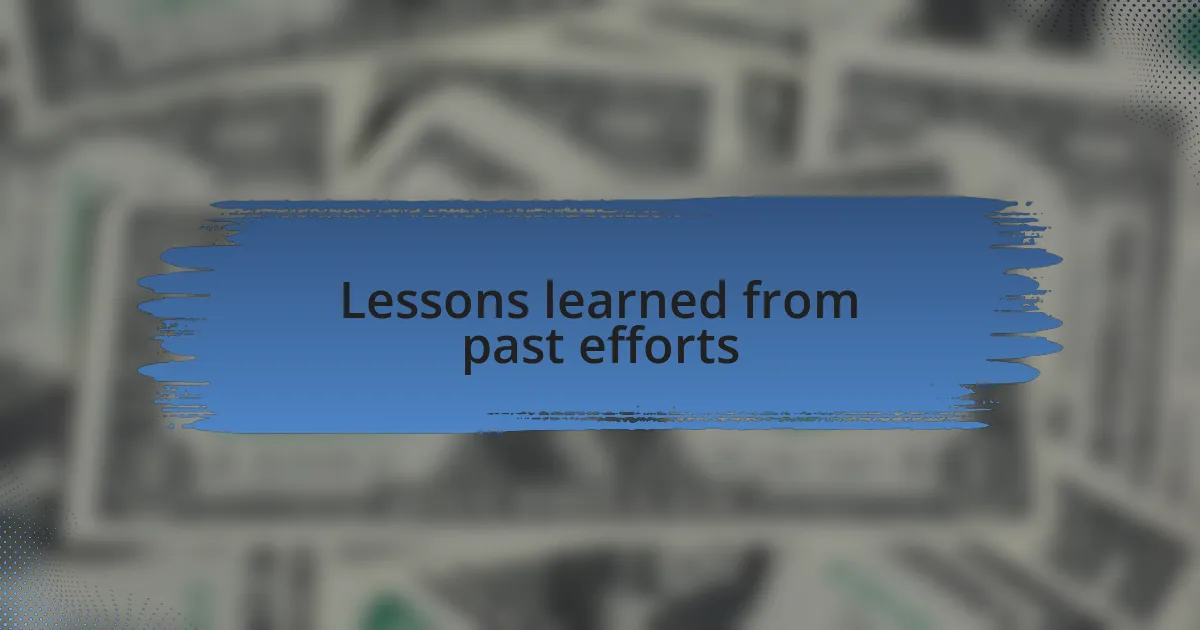
Lessons learned from past efforts
Reflecting on previous petition efforts, one key lesson I learned is the importance of clarity in messaging. I recall a campaign where our message got lost amid too many facts and figures. Simplifying our request helped us connect with a wider audience, turning cold data into a heartfelt plea for fairness. How could we have overlooked that? It’s a vital reminder that in advocacy, clarity is not just helpful; it’s essential.
Additionally, I was part of a team that underestimated the power of timing and external events. A petition we launched coincided with a high-profile equal pay case in the media, which brought our cause into the limelight. People were already energized, and our efforts gained traction quickly. This experience taught me to be aware of the broader context in which we operate. Isn’t it fascinating how the right moment can amplify a message?
Moreover, I’ve witnessed that coalition-building significantly strengthens petitions. In one instance, we joined forces with other advocacy groups, pooling our resources and networks. The variety of voices and stories we presented not only enriched our campaign but also attracted more attention. It’s clear to me now that unity among diverse groups can transform advocacy efforts. Why go it alone when collaboration can make such a difference?